NISSAN LEAF 2017 1.G Owners Manual
Manufacturer: NISSAN, Model Year: 2017, Model line: LEAF, Model: NISSAN LEAF 2017 1.GPages: 424, PDF Size: 4.51 MB
Page 391 of 424
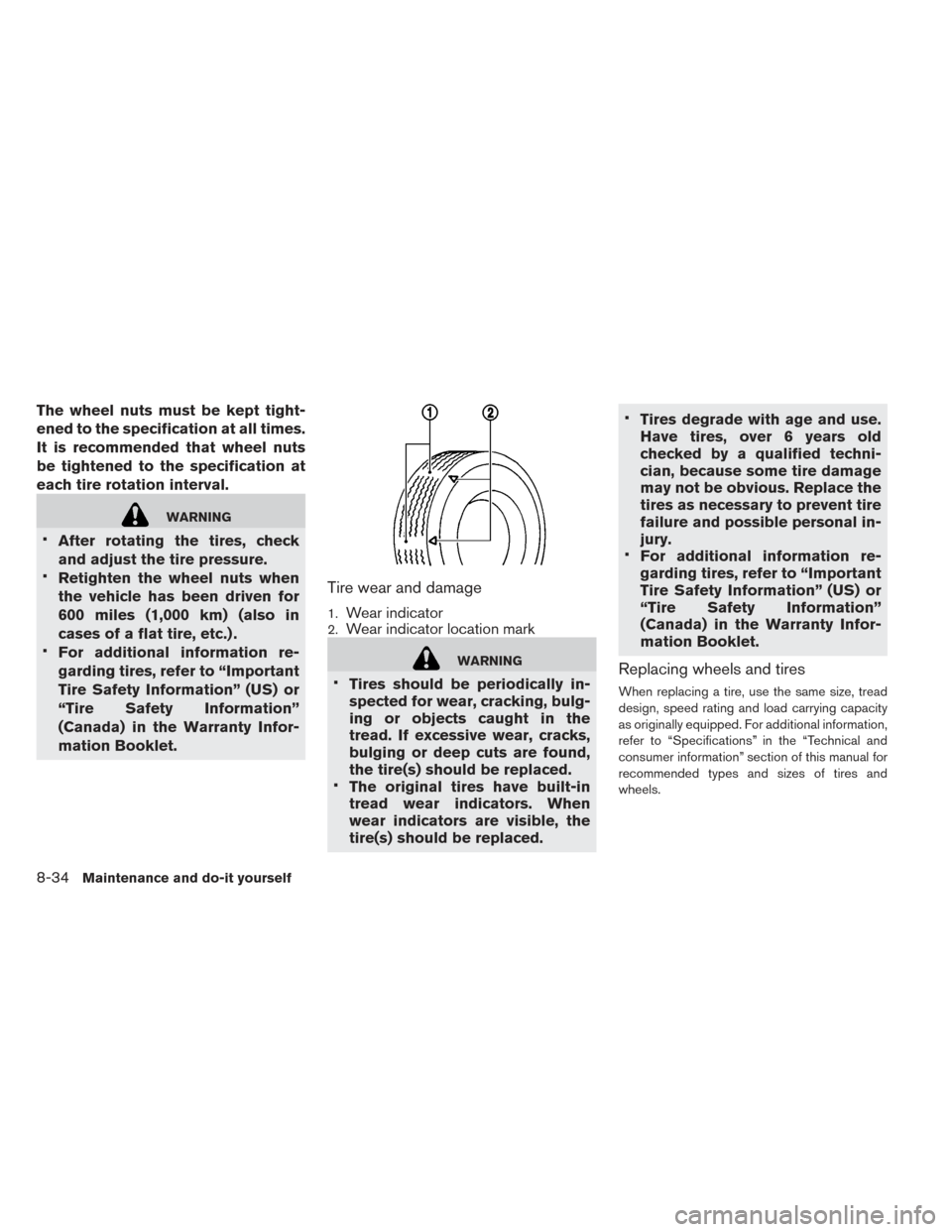
The wheel nuts must be kept tight-
ened to the specification at all times.
It is recommended that wheel nuts
be tightened to the specification at
each tire rotation interval.
WARNING
•
After rotating the tires, check
and adjust the tire pressure.
•Retighten the wheel nuts when
the vehicle has been driven for
600 miles (1,000 km) (also in
cases of a flat tire, etc.) .
•For additional information re-
garding tires, refer to “Important
Tire Safety Information” (US) or
“Tire Safety Information”
(Canada) in the Warranty Infor-
mation Booklet.
Tire wear and damage
1.Wear indicator
2.Wear indicator location mark
WARNING
•
Tires should be periodically in-
spected for wear, cracking, bulg-
ing or objects caught in the
tread. If excessive wear, cracks,
bulging or deep cuts are found,
the tire(s) should be replaced.
•The original tires have built-in
tread wear indicators. When
wear indicators are visible, the
tire(s) should be replaced.
•Tires degrade with age and use.
Have tires, over 6 years old
checked by a qualified techni-
cian, because some tire damage
may not be obvious. Replace the
tires as necessary to prevent tire
failure and possible personal in-
jury.
•For additional information re-
garding tires, refer to “Important
Tire Safety Information” (US) or
“Tire Safety Information”
(Canada) in the Warranty Infor-
mation Booklet.
Replacing wheels and tires
When replacing a tire, use the same size, tread
design, speed rating and load carrying capacity
as originally equipped. For additional information,
refer to “Specifications” in the “Technical and
consumer information” section of this manual for
recommended types and sizes of tires and
wheels.
8-34Maintenance and do-it yourself
Page 392 of 424
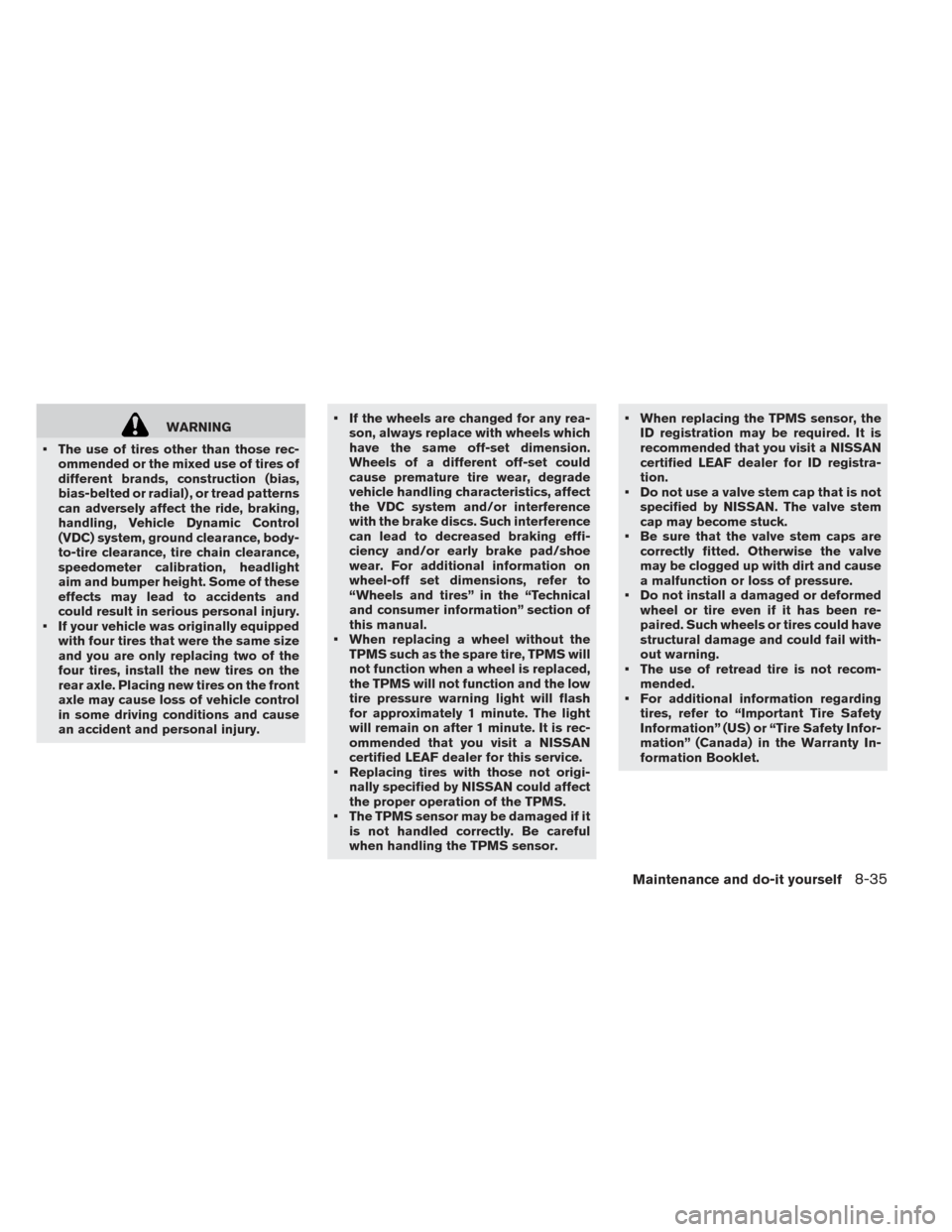
WARNING
• The use of tires other than those rec- ommended or the mixed use of tires of
different brands, construction (bias,
bias-belted or radial) , or tread patterns
can adversely affect the ride, braking,
handling, Vehicle Dynamic Control
(VDC) system, ground clearance, body-
to-tire clearance, tire chain clearance,
speedometer calibration, headlight
aim and bumper height. Some of these
effects may lead to accidents and
could result in serious personal injury.
• If your vehicle was originally equipped with four tires that were the same size
and you are only replacing two of the
four tires, install the new tires on the
rear axle. Placing new tires on the front
axle may cause loss of vehicle control
in some driving conditions and cause
an accident and personal injury. • If the wheels are changed for any rea-
son, always replace with wheels which
have the same off-set dimension.
Wheels of a different off-set could
cause premature tire wear, degrade
vehicle handling characteristics, affect
the VDC system and/or interference
with the brake discs. Such interference
can lead to decreased braking effi-
ciency and/or early brake pad/shoe
wear. For additional information on
wheel-off set dimensions, refer to
“Wheels and tires” in the “Technical
and consumer information” section of
this manual.
• When replacing a wheel without the TPMS such as the spare tire, TPMS will
not function when a wheel is replaced,
the TPMS will not function and the low
tire pressure warning light will flash
for approximately 1 minute. The light
will remain on after 1 minute. It is rec-
ommended that you visit a NISSAN
certified LEAF dealer for this service.
• Replacing tires with those not origi- nally specified by NISSAN could affect
the proper operation of the TPMS.
• The TPMS sensor may be damaged if it is not handled correctly. Be careful
when handling the TPMS sensor. • When replacing the TPMS sensor, the
ID registration may be required. It is
recommended that you visit a NISSAN
certified LEAF dealer for ID registra-
tion.
• Do not use a valve stem cap that is not specified by NISSAN. The valve stem
cap may become stuck.
• Be sure that the valve stem caps are correctly fitted. Otherwise the valve
may be clogged up with dirt and cause
a malfunction or loss of pressure.
• Do not install a damaged or deformed wheel or tire even if it has been re-
paired. Such wheels or tires could have
structural damage and could fail with-
out warning.
• The use of retread tire is not recom- mended.
• For additional information regarding tires, refer to “Important Tire Safety
Information” (US) or “Tire Safety Infor-
mation” (Canada) in the Warranty In-
formation Booklet.
Maintenance and do-it yourself8-35
Page 393 of 424
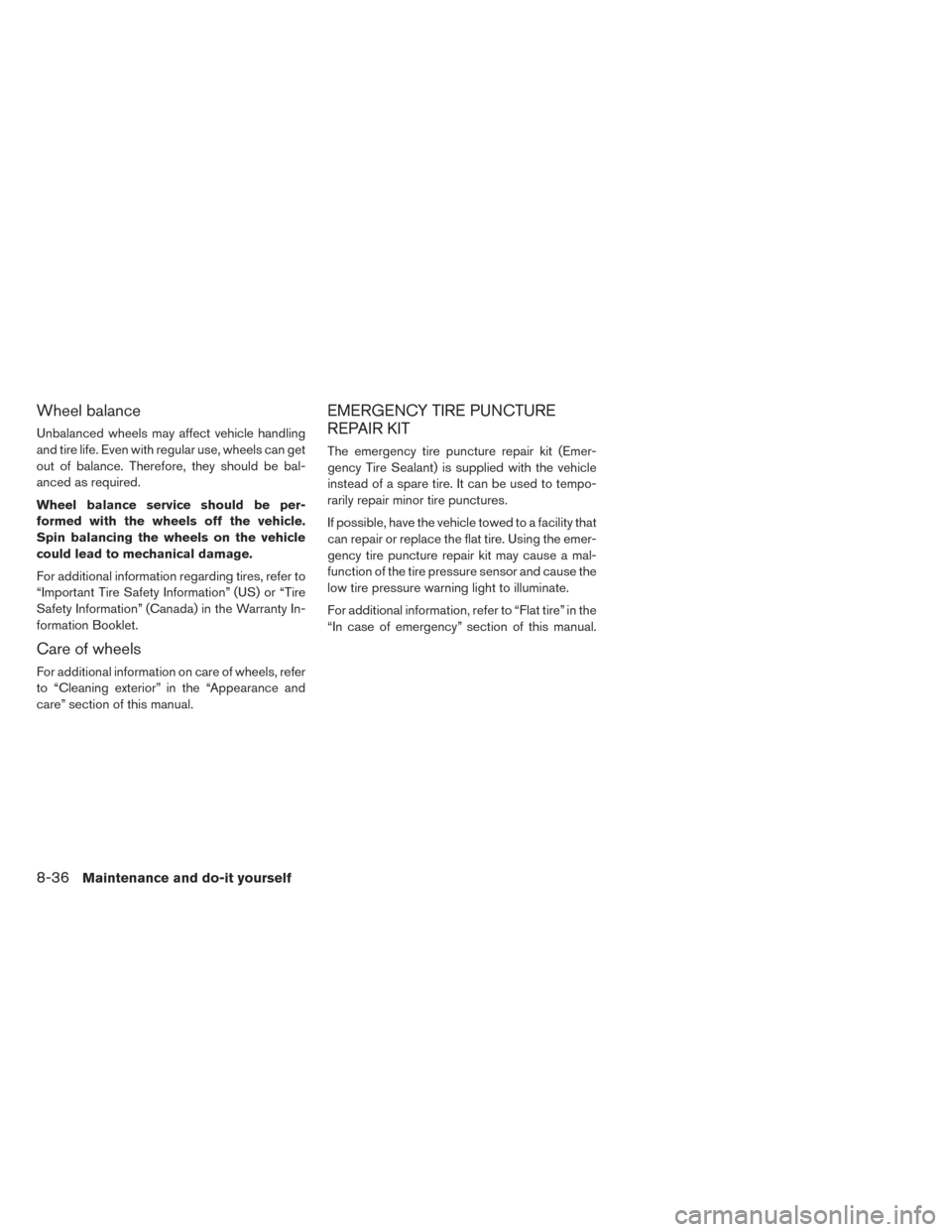
Wheel balance
Unbalanced wheels may affect vehicle handling
and tire life. Even with regular use, wheels can get
out of balance. Therefore, they should be bal-
anced as required.
Wheel balance service should be per-
formed with the wheels off the vehicle.
Spin balancing the wheels on the vehicle
could lead to mechanical damage.
For additional information regarding tires, refer to
“Important Tire Safety Information” (US) or “Tire
Safety Information” (Canada) in the Warranty In-
formation Booklet.
Care of wheels
For additional information on care of wheels, refer
to “Cleaning exterior” in the “Appearance and
care” section of this manual.
EMERGENCY TIRE PUNCTURE
REPAIR KIT
The emergency tire puncture repair kit (Emer-
gency Tire Sealant) is supplied with the vehicle
instead of a spare tire. It can be used to tempo-
rarily repair minor tire punctures.
If possible, have the vehicle towed to a facility that
can repair or replace the flat tire. Using the emer-
gency tire puncture repair kit may cause a mal-
function of the tire pressure sensor and cause the
low tire pressure warning light to illuminate.
For additional information, refer to “Flat tire” in the
“In case of emergency” section of this manual.
8-36Maintenance and do-it yourself
Page 394 of 424
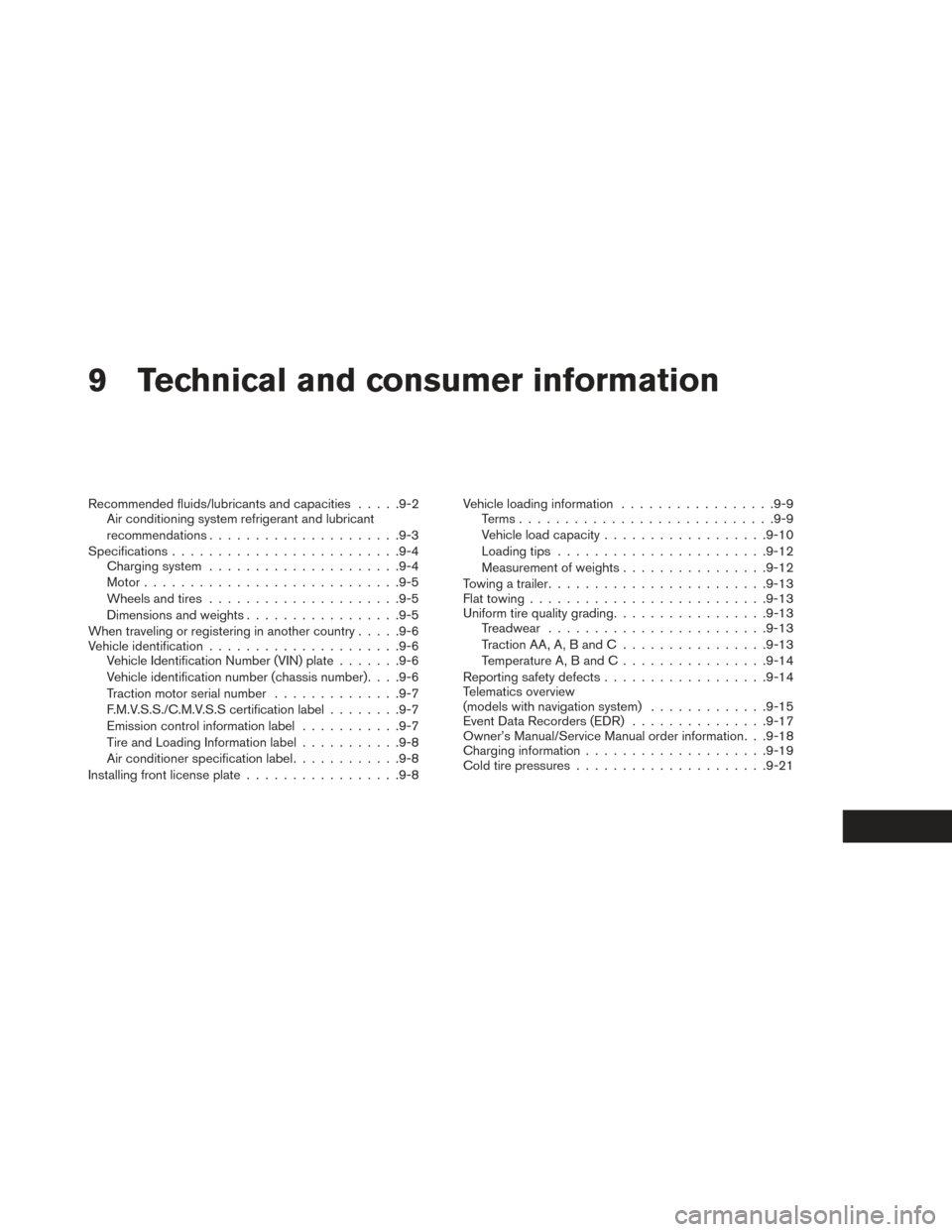
9 Technical and consumer information
Recommended fluids/lubricants and capacities.....9-2
Air conditioning system refrigerant and lubricant
recommendations .................... .9-3
Specifications ........................ .9-4
Charging system .................... .9-4
Motor ........................... .9-5
Wheels and tires .................... .9-5
Dimensions and weights ................ .9-5
When traveling or registering in another country .....9-6
Vehicle identification .................... .9-6
Vehicle Identification Number (VIN) plate .......9-6
Vehicle identification number (chassis number). . . .9-6
Traction motor serial number ..............9-7
F.M.V.S.S./C.M.V.S.S certification label ........9-7
Emission control information label ...........9-7
Tire and Loading Information label ...........9-8
Air conditioner specification label ............9-8
Installing front license plate .................9-8Vehicle loading information
.................9-9
Terms ........................... .9-9
Vehicle load capacity ................. .9-10
Loading tips ...................... .9-12
Measurement of weights ................9-12
Towing a trailer ....................... .9-13
Flat towing ......................... .9-13
Uniform tire quality grading .................9-13
Treadwear ....................... .9-13
Traction AA, A, B and C ................9-13
Temperature A, B and C ................9-14
Reporting safety defects ................. .9-14
Telematics overview
(models with navigation system) .............9-15
Event Data Recorders (EDR) ...............9-17
Owner’s Manual/Service Manual order information. . .9-18
Charging information ................... .9-19
Cold tire pressures .................... .9-21
Page 395 of 424
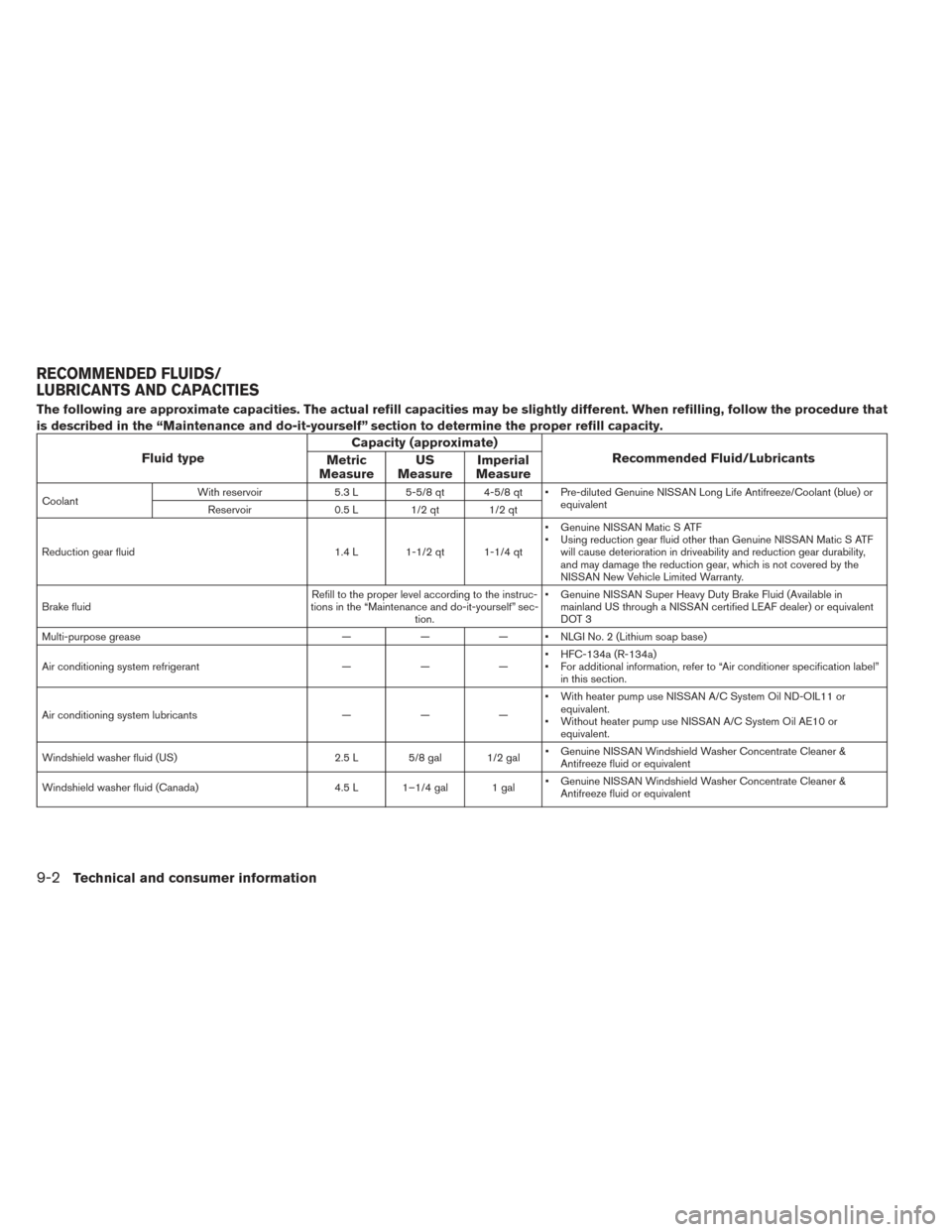
The following are approximate capacities. The actual refill capacities may be slightly different. When refilling, follow the procedure that
is described in the “Maintenance and do-it-yourself” section to determine the proper refill capacity.
Fluid typeCapacity (approximate)
Recommended Fluid/Lubricants
Metric
Measure US
Measure Imperial
Measure
Coolant With reservoir
5.3 L 5-5/8 qt 4-5/8 qt • Pre-diluted Genuine NISSAN Long Life Antifreeze/Coolant (blue) or
equivalent
Reservoir 0.5 L 1/2 qt 1/2 qt
Reduction gear fluid 1.4 L 1-1/2 qt 1-1/4 qt• Genuine NISSAN Matic S ATF
• Using reduction gear fluid other than Genuine NISSAN Matic S ATF
will cause deterioration in driveability and reduction gear durability,
and may damage the reduction gear, which is not covered by the
NISSAN New Vehicle Limited Warranty.
Brake fluid Refill to the proper level according to the instruc-
tions in the “Maintenance and do-it-yourself” sec- tion. • Genuine NISSAN Super Heavy Duty Brake Fluid (Available in
mainland US through a NISSAN certified LEAF dealer) or equivalent
DOT 3
Multi-purpose grease ——— • NLGI No. 2 (Lithium soap base)
Air conditioning system refrigerant ———• HFC-134a (R-134a)
• For additional information, refer to “Air conditioner specification label”
in this section.
Air conditioning system lubricants ———• With heater pump use NISSAN A/C System Oil ND-OIL11 or
equivalent.
• Without heater pump use NISSAN A/C System Oil AE10 or equivalent.
Windshield washer fluid (US) 2.5 L 5/8 gal 1/2 gal• Genuine NISSAN Windshield Washer Concentrate Cleaner &
Antifreeze fluid or equivalent
Windshield washer fluid (Canada) 4.5 L 1–1/4 gal 1 gal• Genuine NISSAN Windshield Washer Concentrate Cleaner &
Antifreeze fluid or equivalent
RECOMMENDED FLUIDS/
LUBRICANTS AND CAPACITIES
9-2Technical and consumer information
Page 396 of 424
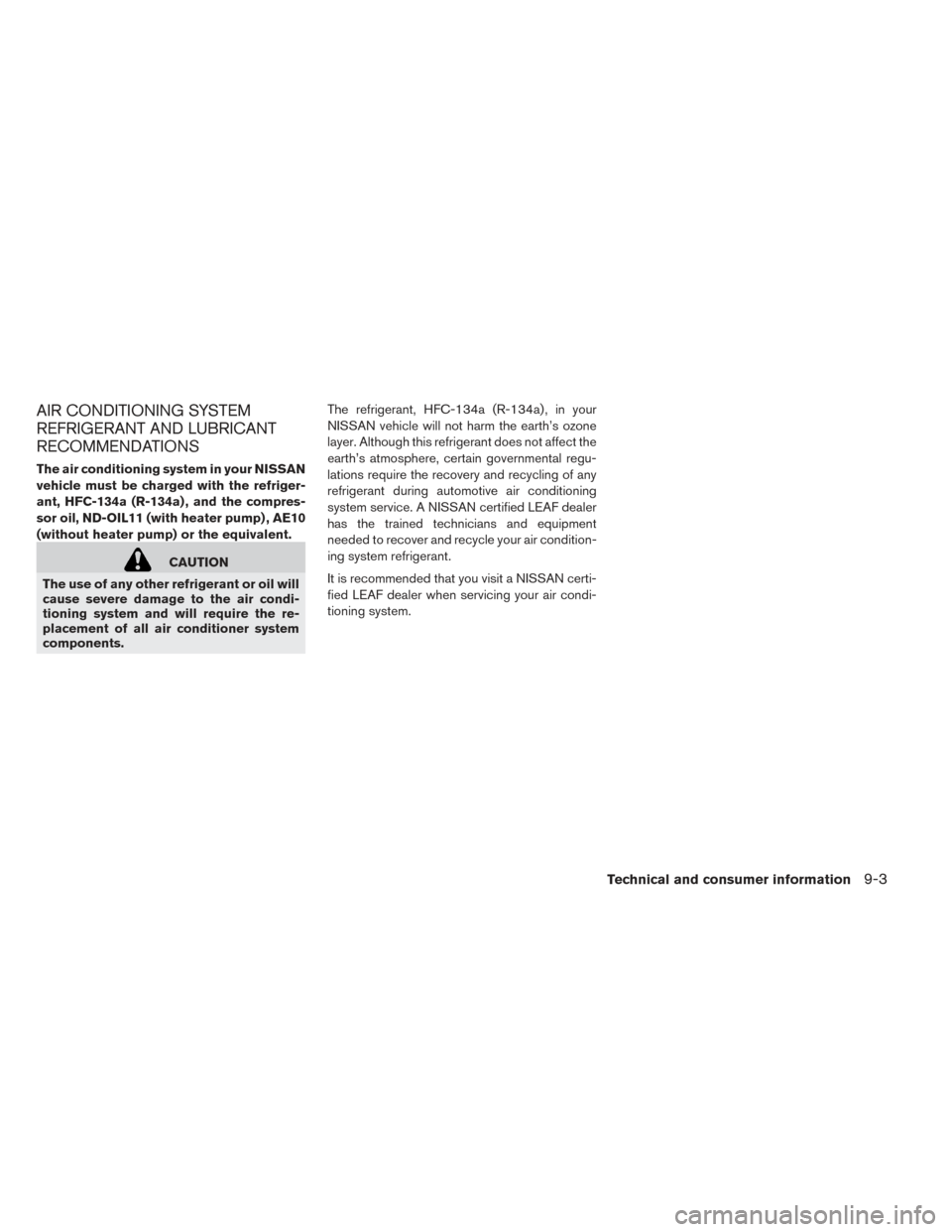
AIR CONDITIONING SYSTEM
REFRIGERANT AND LUBRICANT
RECOMMENDATIONS
The air conditioning system in your NISSAN
vehicle must be charged with the refriger-
ant, HFC-134a (R-134a) , and the compres-
sor oil, ND-OIL11 (with heater pump) , AE10
(without heater pump) or the equivalent.
CAUTION
The use of any other refrigerant or oil will
cause severe damage to the air condi-
tioning system and will require the re-
placement of all air conditioner system
components. The refrigerant, HFC-134a (R-134a) , in your
NISSAN vehicle will not harm the earth’s ozone
layer. Although this refrigerant does not affect the
earth’s atmosphere, certain governmental regu-
lations require the recovery and recycling of any
refrigerant during automotive air conditioning
system service. A NISSAN certified LEAF dealer
has the trained technicians and equipment
needed to recover and recycle your air condition-
ing system refrigerant.
It is recommended that you visit a NISSAN certi-
fied LEAF dealer when servicing your air condi-
tioning system.
Technical and consumer information9-3
Page 397 of 424
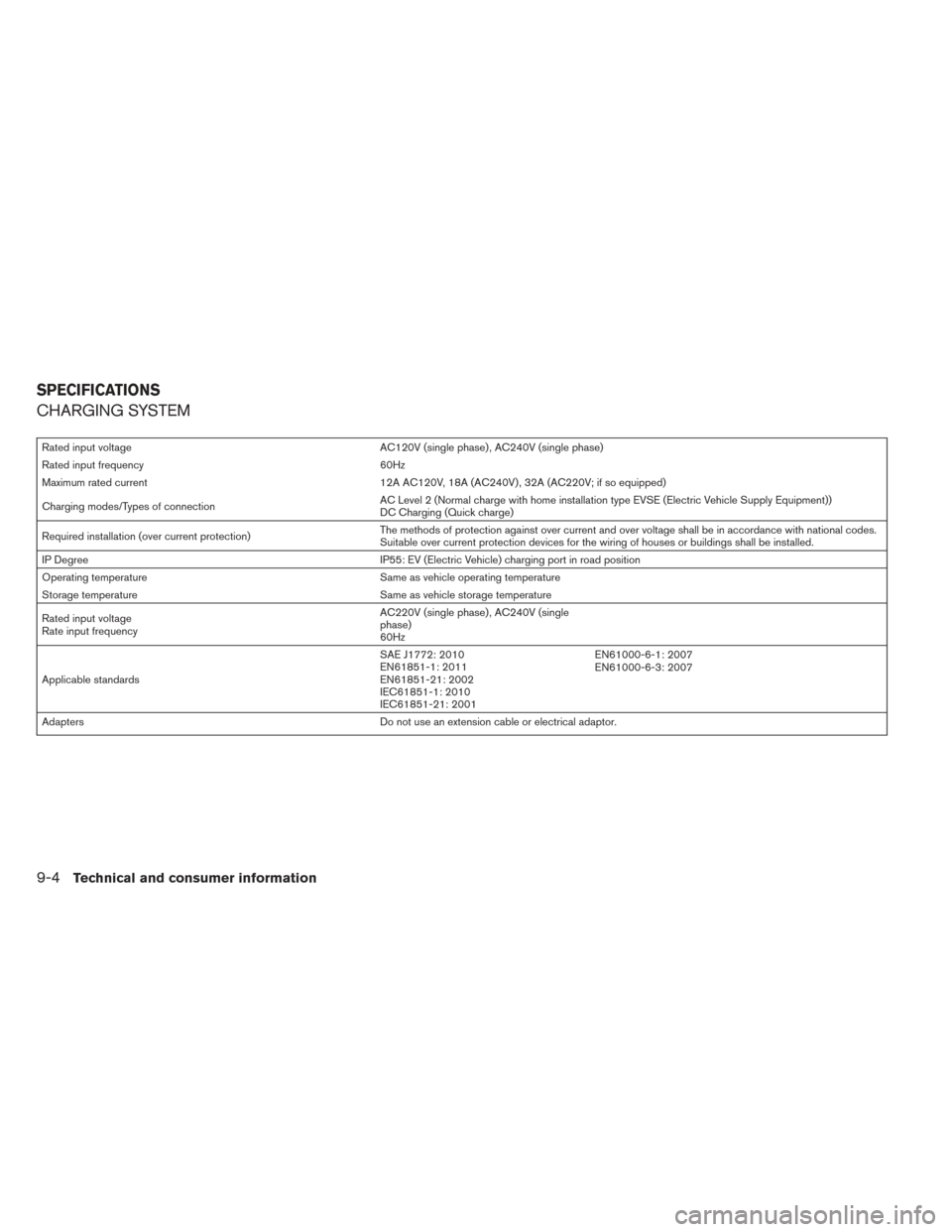
CHARGING SYSTEM
Rated input voltageAC120V (single phase) , AC240V (single phase)
Rated input frequency 60Hz
Maximum rated current 12A AC120V, 18A (AC240V) , 32A (AC220V; if so equipped)
Charging modes/Types of connection AC Level 2 (Normal charge with home installation type EVSE (Electric Vehicle Supply Equipment))
DC Charging (Quick charge)
Required installation (over current protection) The methods of protection against over current and over voltage shall be in accordance with national codes.
Suitable over current protection devices for the wiring of houses or buildings shall be installed.
IP Degree IP55: EV (Electric Vehicle) charging port in road position
Operating temperature Same as vehicle operating temperature
Storage temperature Same as vehicle storage temperature
Rated input voltage
Rate input frequency AC220V (single phase) , AC240V (single
phase)
60Hz
Applicable standards SAE J1772: 2010
EN61851-1: 2011
EN61851-21: 2002
IEC61851-1: 2010
IEC61851-21: 2001EN61000-6-1: 2007
EN61000-6-3: 2007
Adapters Do not use an extension cable or electrical adaptor.
SPECIFICATIONS
9-4Technical and consumer information
Page 398 of 424
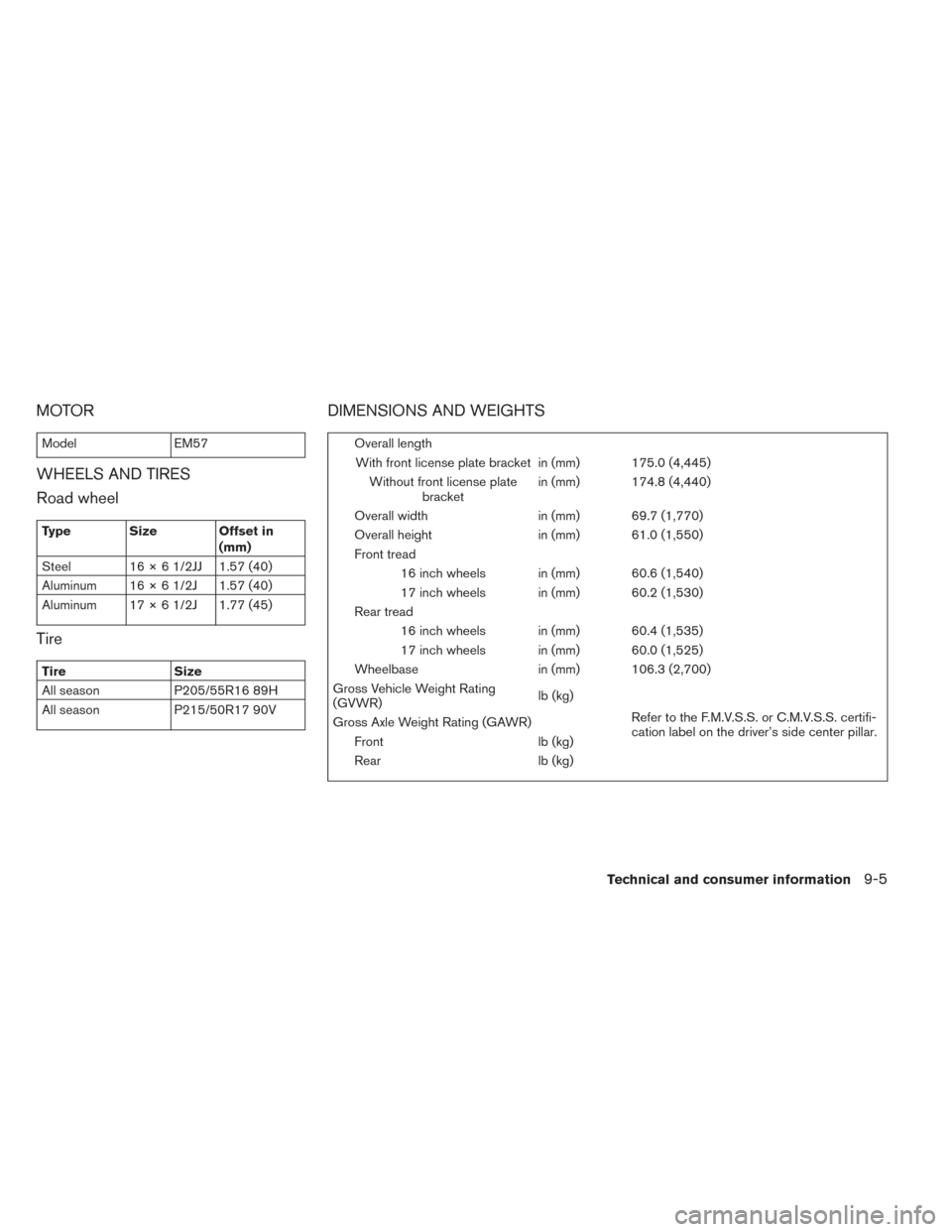
MOTOR
ModelEM57
WHEELS AND TIRES
Road wheel
Type Size Offset in
(mm)
Steel 16 × 6 1/2JJ 1.57 (40)
Aluminum 16 × 6 1/2J 1.57 (40)
Aluminum 17 × 6 1/2J 1.77 (45)
Tire
Tire Size
All season P205/55R16 89H
All season P215/50R17 90V
DIMENSIONS AND WEIGHTS
Overall length
With front license plate bracket in (mm) 175.0 (4,445) Without front license plate bracket in (mm) 174.8 (4,440)
Overall width in (mm) 69.7 (1,770)
Overall height in (mm) 61.0 (1,550)
Front tread 16 inch wheels in (mm) 60.6 (1,540)
17 inch wheels in (mm) 60.2 (1,530)
Rear tread 16 inch wheels in (mm) 60.4 (1,535)
17 inch wheels in (mm) 60.0 (1,525)
Wheelbase in (mm) 106.3 (2,700)
Gross Vehicle Weight Rating
(GVWR) lb (kg)
Refer to the F.M.V.S.S. or C.M.V.S.S. certifi-
cation label on the driver’s side center pillar.
Gross Axle Weight Rating (GAWR)
Front lb (kg)
Rear lb (kg)
Technical and consumer information9-5
Page 399 of 424
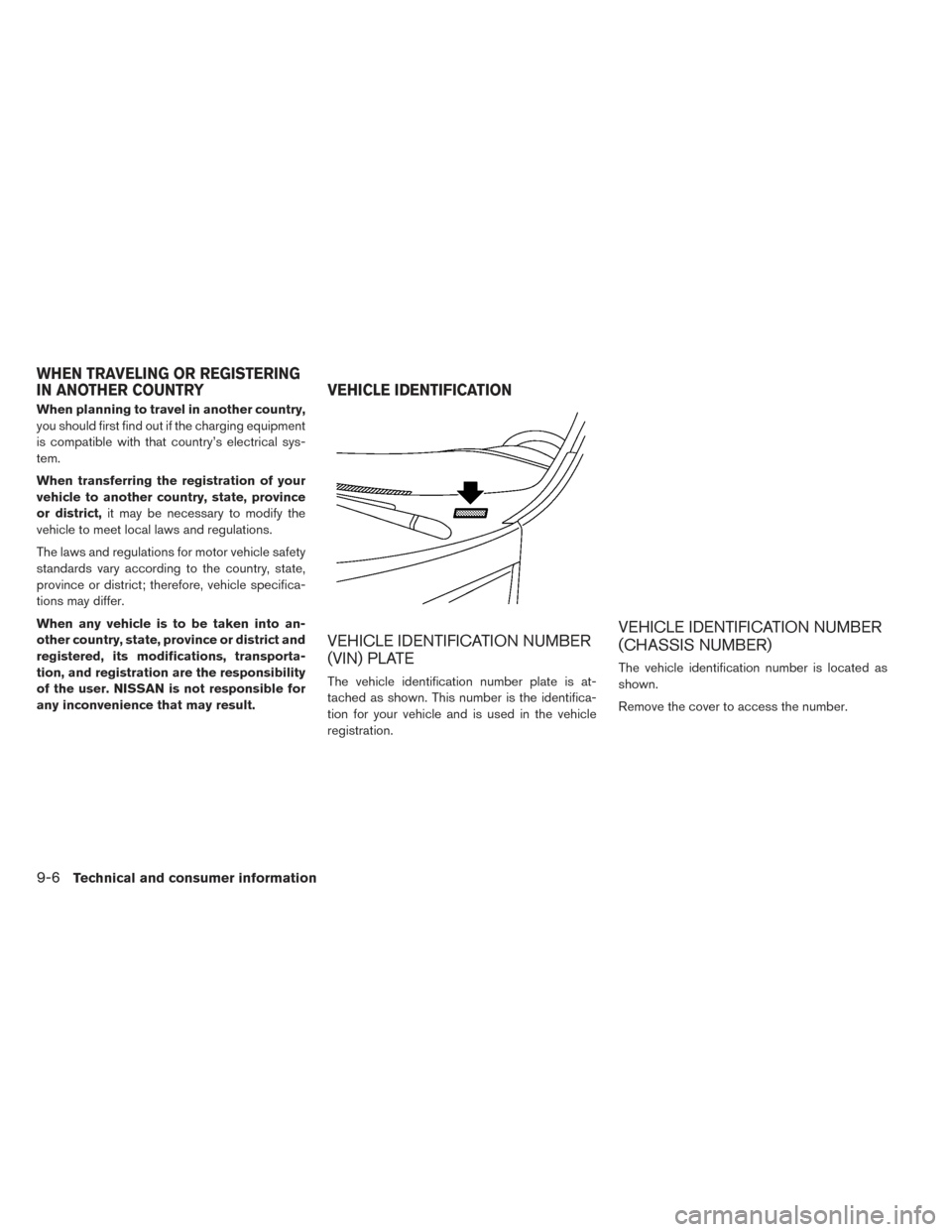
When planning to travel in another country,
you should first find out if the charging equipment
is compatible with that country’s electrical sys-
tem.
When transferring the registration of your
vehicle to another country, state, province
or district,it may be necessary to modify the
vehicle to meet local laws and regulations.
The laws and regulations for motor vehicle safety
standards vary according to the country, state,
province or district; therefore, vehicle specifica-
tions may differ.
When any vehicle is to be taken into an-
other country, state, province or district and
registered, its modifications, transporta-
tion, and registration are the responsibility
of the user. NISSAN is not responsible for
any inconvenience that may result.
VEHICLE IDENTIFICATION NUMBER
(VIN) PLATE
The vehicle identification number plate is at-
tached as shown. This number is the identifica-
tion for your vehicle and is used in the vehicle
registration.
VEHICLE IDENTIFICATION NUMBER
(CHASSIS NUMBER)
The vehicle identification number is located as
shown.
Remove the cover to access the number.
WHEN TRAVELING OR REGISTERING
IN ANOTHER COUNTRY VEHICLE IDENTIFICATION
9-6Technical and consumer information
Page 400 of 424
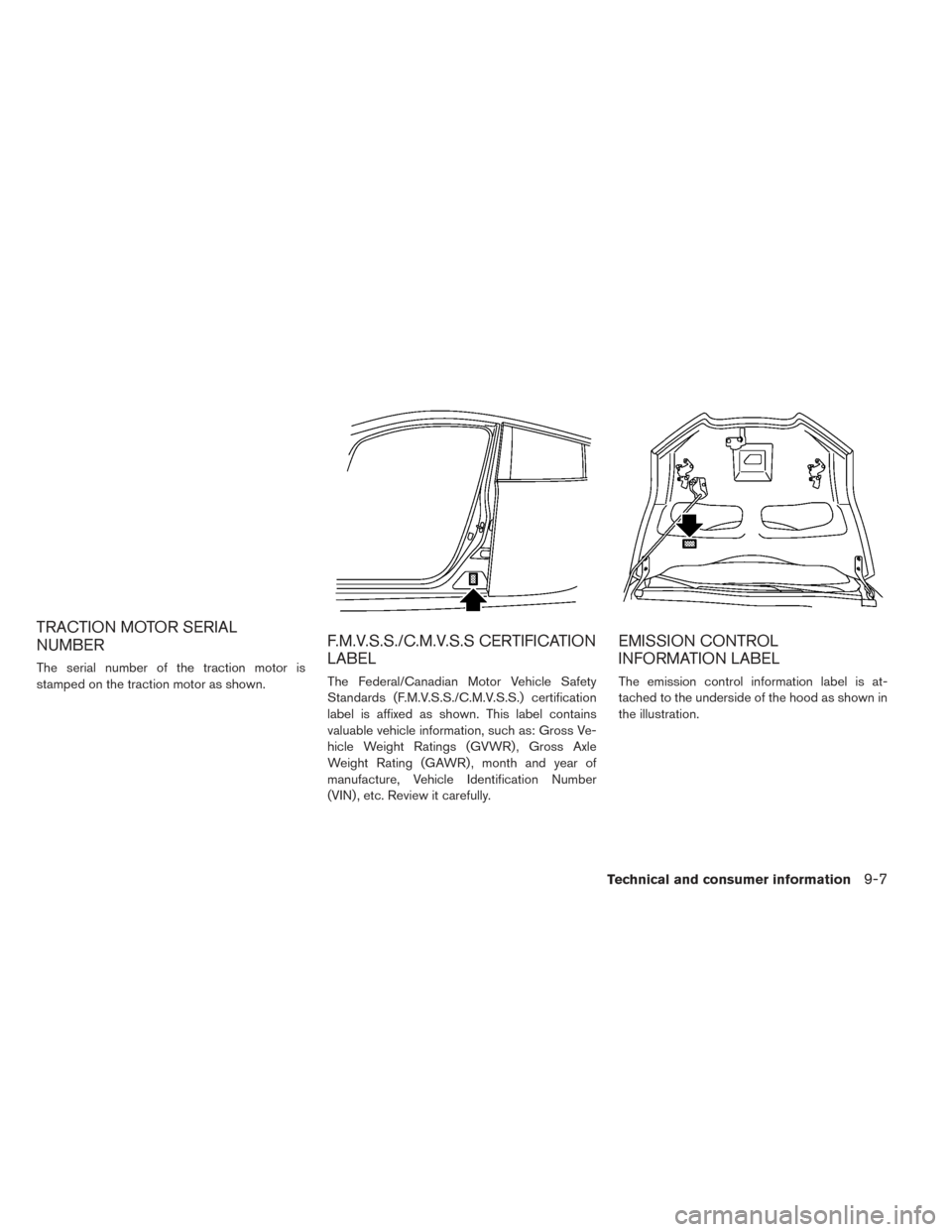
TRACTION MOTOR SERIAL
NUMBER
The serial number of the traction motor is
stamped on the traction motor as shown.
F.M.V.S.S./C.M.V.S.S CERTIFICATION
LABEL
The Federal/Canadian Motor Vehicle Safety
Standards (F.M.V.S.S./C.M.V.S.S.) certification
label is affixed as shown. This label contains
valuable vehicle information, such as: Gross Ve-
hicle Weight Ratings (GVWR) , Gross Axle
Weight Rating (GAWR) , month and year of
manufacture, Vehicle Identification Number
(VIN) , etc. Review it carefully.
EMISSION CONTROL
INFORMATION LABEL
The emission control information label is at-
tached to the underside of the hood as shown in
the illustration.
Technical and consumer information9-7